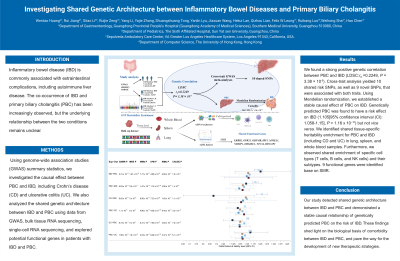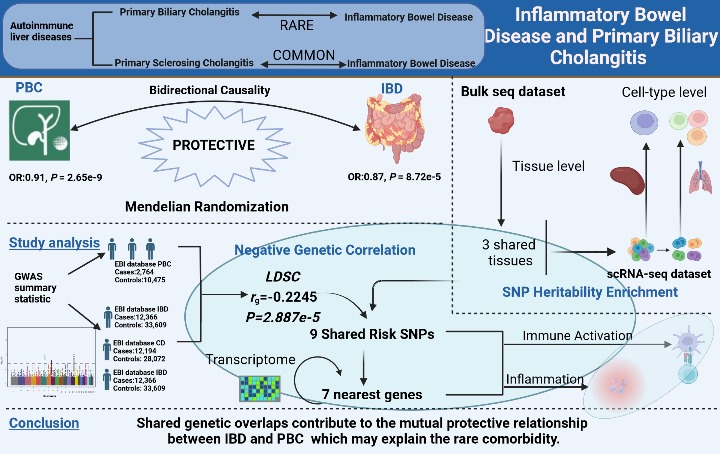Sunday Poster Session
Category: IBD
P0695 - Shared Genetic Architecture and Protective Causal Association Between Inflammatory Bowel Diseases and Primary Biliary Cholangitis
Sunday, October 22, 2023
3:30 PM - 7:00 PM PT
Location: Exhibit Hall

Has Audio

Wentao Huang, MD
Guangdong Provincial People's Hospital
Guangzhou, Guangdong, China (People's Republic)
Presenting Author(s)
Wentao Huang, MD1, Rui Jiang, MD1, Ruijie Zeng, MD1, Lijun Zhang, MD1, Shuangshuang Tong, MD1, Yuying Ma, MD1, Yanlin Lyu, MD1, Jiaxuan Wang, MD1, Felix W. Leung, MD, FACG2, Weihong Sha, PhD1, Hao Chen, PhD1
1Guangdong Provincial People's Hospital, Guangzhou, Guangdong, China; 2Sepulveda ACC/VAGLAHS/UCLA, North Hills, CA
Introduction: Inflammatory bowel disease (IBD) and primary sclerosing cholangitis (PSC) have been found to have comorbidity in clinical studies, but the coexistence of IBD and primary biliary cholangitis (PBC) is rare. The potential relationship between IBD and PBC remains unclear.
Methods: We investigated the causal effect between PBC and IBD, including Crohn’s disease (CD) and ulcerative Colitis (UC), using genome-wide association studies (GWAS) summary statistics. We analyzed the shared genetic architecture between IBD and PBC using data from GWAS, bulk tissue RNA sequencing, and single-cell RNA sequencing. The transcriptomic expressions of shared genes were explored in patients with IBD (intestinal biopsies) and PBC (peripheral CD4+ T cells).
Results: We found a bidirectional causal relationship for PBC and IBDs using Mendelian randomization. IBD appeared to have a protective effect on PBC (0.87[95% confidence interval (CI): 0.81-0.93], P = 8.72e-5) and vice versa (0.91[95% CI: 0.81-0.93], P = 2.65e-09). We found a consistent negative genetic correlation between PBC and IBD (LDSC: rg = -0.2245, P = 2.89e-5). Cross-trait analysis yielded 9 shared risk SNPs and 7 nearest genes. In transcriptome analysis, we observed significant (P < 0.05) differences in intestinal biopsies (PGAP3 and DENND1B) and in peripheral CD4+ T cells (PTPN11 and PNMT). We identified shared tissue-specific heritability enrichment for PBC and IBD (including CD not UC) in lung, spleen and cells EBV-transformed lymphocytes. There was shared cell type-level enrichment for IBD, CD and PBC in type 1 dendritic cells, natural killer cells, CD8+ cytotoxic T lymphocytes in lung and activated CD8+ T cell in spleen.
Discussion: Our study revealed a share genetic architecture between IBD and PBC. The apparent mutual protective relationship appeared to be based on a negative genetic correlation. These findings may offer guidance to develop new immune based therapies target and shed light on the low co-occurrence between IBD and PBC.

Disclosures:
Wentao Huang, MD1, Rui Jiang, MD1, Ruijie Zeng, MD1, Lijun Zhang, MD1, Shuangshuang Tong, MD1, Yuying Ma, MD1, Yanlin Lyu, MD1, Jiaxuan Wang, MD1, Felix W. Leung, MD, FACG2, Weihong Sha, PhD1, Hao Chen, PhD1. P0695 - Shared Genetic Architecture and Protective Causal Association Between Inflammatory Bowel Diseases and Primary Biliary Cholangitis, ACG 2023 Annual Scientific Meeting Abstracts. Vancouver, BC, Canada: American College of Gastroenterology.
1Guangdong Provincial People's Hospital, Guangzhou, Guangdong, China; 2Sepulveda ACC/VAGLAHS/UCLA, North Hills, CA
Introduction: Inflammatory bowel disease (IBD) and primary sclerosing cholangitis (PSC) have been found to have comorbidity in clinical studies, but the coexistence of IBD and primary biliary cholangitis (PBC) is rare. The potential relationship between IBD and PBC remains unclear.
Methods: We investigated the causal effect between PBC and IBD, including Crohn’s disease (CD) and ulcerative Colitis (UC), using genome-wide association studies (GWAS) summary statistics. We analyzed the shared genetic architecture between IBD and PBC using data from GWAS, bulk tissue RNA sequencing, and single-cell RNA sequencing. The transcriptomic expressions of shared genes were explored in patients with IBD (intestinal biopsies) and PBC (peripheral CD4+ T cells).
Results: We found a bidirectional causal relationship for PBC and IBDs using Mendelian randomization. IBD appeared to have a protective effect on PBC (0.87[95% confidence interval (CI): 0.81-0.93], P = 8.72e-5) and vice versa (0.91[95% CI: 0.81-0.93], P = 2.65e-09). We found a consistent negative genetic correlation between PBC and IBD (LDSC: rg = -0.2245, P = 2.89e-5). Cross-trait analysis yielded 9 shared risk SNPs and 7 nearest genes. In transcriptome analysis, we observed significant (P < 0.05) differences in intestinal biopsies (PGAP3 and DENND1B) and in peripheral CD4+ T cells (PTPN11 and PNMT). We identified shared tissue-specific heritability enrichment for PBC and IBD (including CD not UC) in lung, spleen and cells EBV-transformed lymphocytes. There was shared cell type-level enrichment for IBD, CD and PBC in type 1 dendritic cells, natural killer cells, CD8+ cytotoxic T lymphocytes in lung and activated CD8+ T cell in spleen.
Discussion: Our study revealed a share genetic architecture between IBD and PBC. The apparent mutual protective relationship appeared to be based on a negative genetic correlation. These findings may offer guidance to develop new immune based therapies target and shed light on the low co-occurrence between IBD and PBC.

Figure: graph abstract
Disclosures:
Wentao Huang indicated no relevant financial relationships.
Rui Jiang indicated no relevant financial relationships.
Ruijie Zeng indicated no relevant financial relationships.
Lijun Zhang indicated no relevant financial relationships.
Shuangshuang Tong indicated no relevant financial relationships.
Yuying Ma indicated no relevant financial relationships.
Yanlin Lyu indicated no relevant financial relationships.
Jiaxuan Wang indicated no relevant financial relationships.
Felix Leung indicated no relevant financial relationships.
Weihong Sha indicated no relevant financial relationships.
Hao Chen indicated no relevant financial relationships.
Wentao Huang, MD1, Rui Jiang, MD1, Ruijie Zeng, MD1, Lijun Zhang, MD1, Shuangshuang Tong, MD1, Yuying Ma, MD1, Yanlin Lyu, MD1, Jiaxuan Wang, MD1, Felix W. Leung, MD, FACG2, Weihong Sha, PhD1, Hao Chen, PhD1. P0695 - Shared Genetic Architecture and Protective Causal Association Between Inflammatory Bowel Diseases and Primary Biliary Cholangitis, ACG 2023 Annual Scientific Meeting Abstracts. Vancouver, BC, Canada: American College of Gastroenterology.
